
You probably didn’t think creating a vinyl record was even a thing anymore did you? Well guess what you can do now?
People are actually playing records again. I know, right? Who even has a record player these days? Well, it turns out…quite a few.
Vinylify is a company that makes creating recordings on vinyl – something that has always been quite expensive (not to mention, improbable) – into a much more affordable venture.
If you are interested in finding out more, please check out this link http://vinylify.com/
Recording Tips and Techniques
Be Careful Not To Slice Up All Your Tracks In Reaper
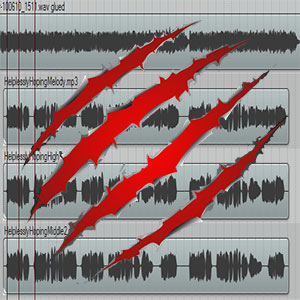 Reaper (http://reaper.fm) is an incredible recording program that I use just about every day. But like any piece of software, it only does what you tell it to do. And over the years, I have made many mistakes that I hope I can keep you from making.
Reaper (http://reaper.fm) is an incredible recording program that I use just about every day. But like any piece of software, it only does what you tell it to do. And over the years, I have made many mistakes that I hope I can keep you from making.
One of those mistakes was accidentally slicing up the audio on all my tracks when I only meant to apply slices to the audio in one track.
What Is A Slice?
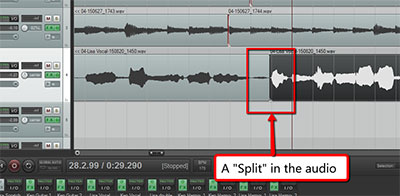
What I actually refer to is called a “Split.” If you have an audio file in a track, it is super easy to split it (into as many pieces as you need) wherever you want, just by placing your cursor and using the keyboard shortcut “S” ( And it’s non-destructive too. If you end up deleting one of the new pieces of audio, all you have to do is drag the edge of the audio item where you split it, and drag it back out to its original length. See Figure 1 to see what a split is.
To create the split in the picture, I clicked on the middle track, on the audio item, and put the cursor where I needed the split. But be careful!
If you use a lot of splits like I do (it’s handy for slicing up drum beats and moving them around), be very careful that before you hit that “S” key, you have selected/highlighted the audio on the track you’re working on! You need to actually click on the audio to do this, which I didn’t know at first. If you ONLY put the cursor where you want it, but no audio is selected (which can happen if you click where there is no audio – an empty part of a track, for example), you’ll end up creating a split at that point in time on every track with audio on it. See Figure 2 for what this would look like.
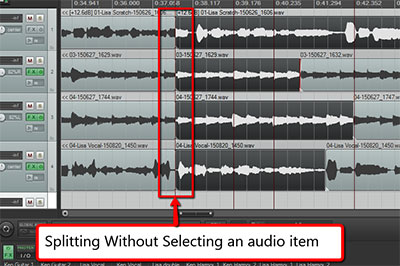
You can make matters even worse (like I did) if you don’t notice that you just put a slice across every track. Let’s say you have 4 tracks and you wanted to put 4 splits into, say, track 4. If you don’t select the audio in track 4 each time you execute the split, you will end up with a total of 16 slices instead of 4! Every track will have 4 splits.
You can end up with an awful mess on you hands if you don’t pay attention to this.
The ability to split an audio item is absolutely awesome. It is a fundamental tool in any audio project I do. You can move portions of audio forward or backward in time, fix timing mistakes music, edit dialogue/conversations, apply effects to one part of an item, etc. But with great power…..
So make sure you have the audio you want to split already selected (you’ll know because it will be highlighted) BEFORE you hit that “S” Key.
A Few Tips for Audio Production
Here is an article by Audio Issues about audio production. Björgvin Benediktsson shares 18 tidbits to try out in your home recording efforts.
A couple of these deal with the concept of stereo, which is not as easy a concept as it might seem. I especially like: “Don’t think that using two mics means it has to be stereo.” What he means by this is that you should maybe try recording with 2 mics at the same time and have them both go to the same track, taking advantage of the combined character of each mic. But it can also be a warning if you ARE trying to record in stereo and forget that you would need to have two tracks panned left and right for that to happen. Many years ago, when I was first starting out, I was trying to record in stereo, but neglected to send each mic to its own track. I unwittingly did what this tip recommends, but ended up with only one track – nothing to pan (unless you do weird tricks after the fact, which is a different thing entirely). Anyway – to learn more about what stereo is, check out our post “5 Audio Recording Tips For Newbies – Part 1: Stereo Or Not?”
Here’s the link to the Audio Issues 18 Tips article: http://www.audio-issues.com/home-recording-studio/18-audio-production-tips-to-start-your-week/
Adding An Effect To Just Part Of An Audio Track In Reaper
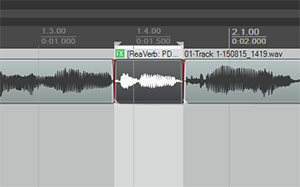 Have you ever been working on mixing audio tracks in a digital audio workstation (DAW) program (such as Reaper, Pro Tools, Sonar, Ableton Live, Logic Pro, etc.), and wanted to apply an effect to only one small section of a track? There don’t seem to be any obvious ways to do it, since effect plugins are almost always applied to the entire track. Well though it isn’t obvious, there is a quick and easy way to do it in Reaper. Here’s how.
Have you ever been working on mixing audio tracks in a digital audio workstation (DAW) program (such as Reaper, Pro Tools, Sonar, Ableton Live, Logic Pro, etc.), and wanted to apply an effect to only one small section of a track? There don’t seem to be any obvious ways to do it, since effect plugins are almost always applied to the entire track. Well though it isn’t obvious, there is a quick and easy way to do it in Reaper. Here’s how.
What’s In A Track?
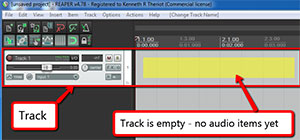
First it might be handy to review what a track actually is. Basically, it’s just a container that we see on the screen of a DAW, usually stretching horizontally across the screen. See Figure 1.
When you record (or insert) some audio, it goes into a track – you can see the “blobs” (the non-technical term for how audio wave forms are visualized:-P) in the track as you record them. When you stop recording, you have created an “audio item” in a track. See figure 2.
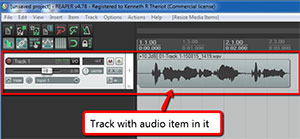
You can add more audio items into the same track, either by recording more audio or inserting a previously recorded audio file. You can also slice up a single audio item. There are several reasons someone might want to do this, but let’s say you have recorded a voice onto a track and want to apply an effect – say, reverb, for example – to JUST one word or phrase of that audio.
Usually, when you want to add an effect in Reaper, you click the “FX button on the track control panel (the area on the left of the track with all the buttons and knobs), and select your plugin. The assumption is that you’d want to apply that effect to the entire track. But that doesn’t help us here, does it? We only want that one phrase to have the reverb on it (this could be any effect though, like EQ or compression, etc.).
Split That Audio
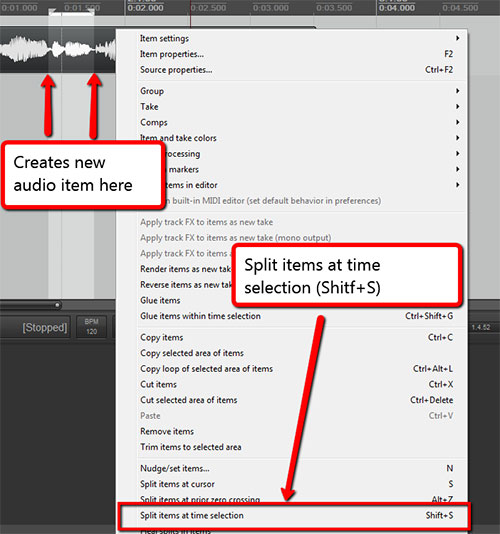
Reaper allows you to apply effects ONLY to an audio item in a track, even if you don’t have an effect selected in the track control panel. So in our example, you’d need to make your phrase its own item by “splitting” it. To do this, highlight the phrase and then right-mouse click anywhere on the audio item. This displays a drop-down menu of all sorts of things you can do to your audio item. We are looking for “Split items at time selection.” See Figure 3.
The keyboard shortcut for this action is “Shift+S.” It places a split at the edges of your selection. So be sure those edges start just before your phrase and end just after it.
Put Effect Only On Your New Item
So now that you’ve created a new audio item for the phrase you want to put reverb on, right mouse-click on your phrase to launch that drop-down menu again. This time, choose “Item Properties,” which brings up the Media Item Properties box. See Figure 4.
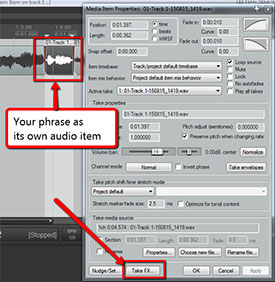
You want the button at the bottom that says “Take FX.” The term “take” is another word for “item” – as in “take 1, take 2,” etc. Anyway, clicking that button allows you to choose a plugin the same way as the “FX” button on the track control panel. But it will only apply that plugin effect to your item – exactly what we wanted. Cool, huh?
It takes a lot longer to explain that to actually do. It’s really easy and can be very useful for a number of things. Maybe you want to use EQ or compression to fix some audio problem in only a couple of places on a track. You can also use this technique to turn the volume down quickly on just a piece of audio by dragging the top of the item down.
So if you were wondering how you could apply an effect to just one small part of a track without affecting the rest of the audio on that track, now you know how to do that in Reaper.
Tips On Setting Up a Basement Video Studio
 Anybody would want their very own video studio in their home, the uses could be endless. Creating a video studio in your own home can be a daunting task, that can be made easier with a few simple steps. Check out these tips on how to set up a video studio in your own home by checking out the article of dlsrvideoshooter.com http://dslrvideoshooter.com/setting-up-a-basement-video-studio/
Anybody would want their very own video studio in their home, the uses could be endless. Creating a video studio in your own home can be a daunting task, that can be made easier with a few simple steps. Check out these tips on how to set up a video studio in your own home by checking out the article of dlsrvideoshooter.com http://dslrvideoshooter.com/setting-up-a-basement-video-studio/